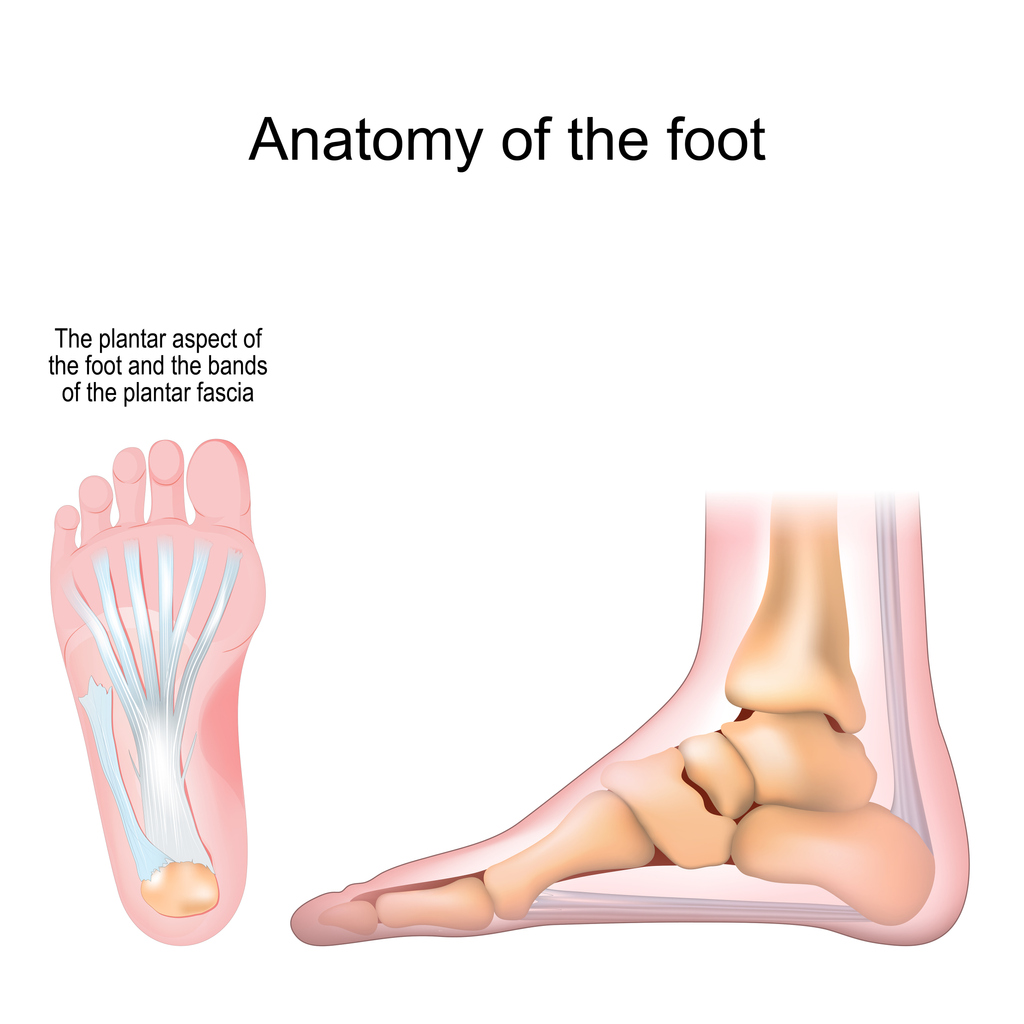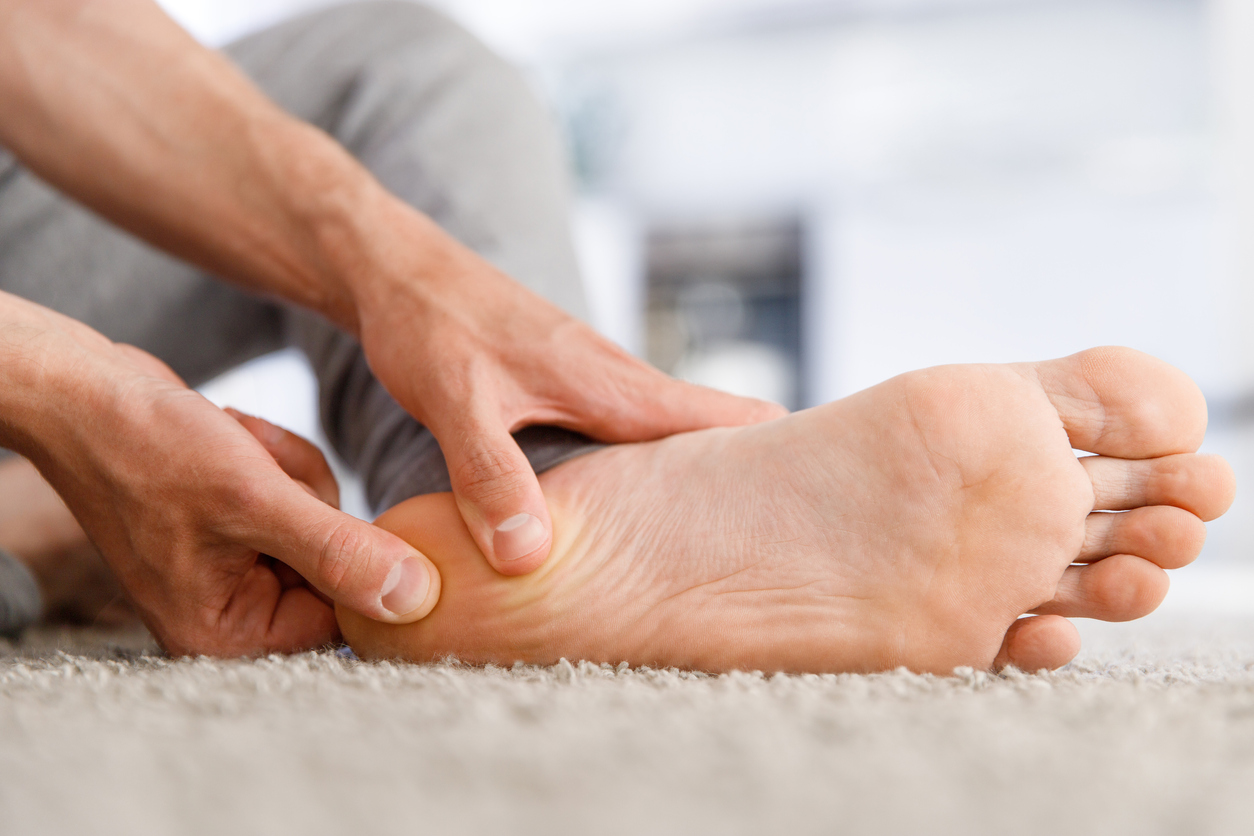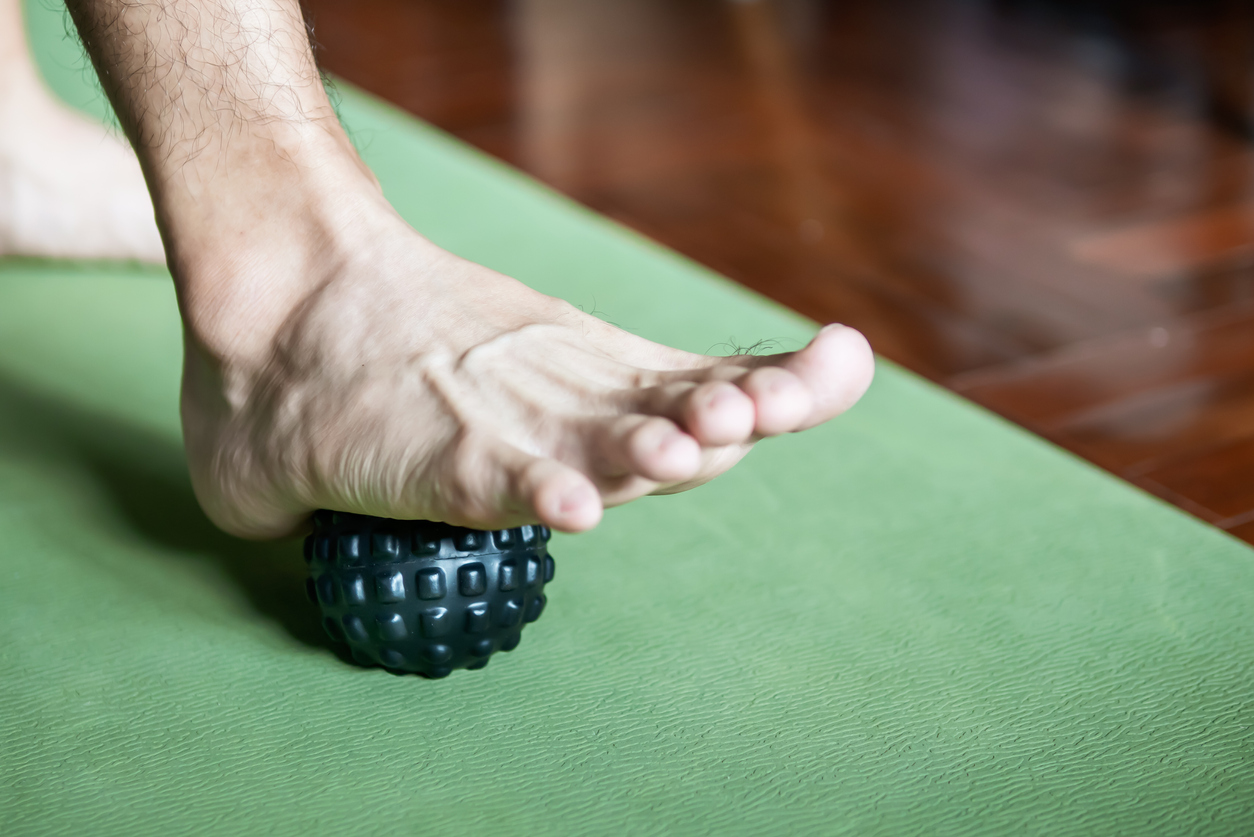Have you ever experienced a particularly bad pain in the heels of your feet when you stand after resting or sleeping for a period? This pain may have dissipated after a few minutes only to recur once you have been standing for a little while. If this sounds familiar then there is a distinct possibility that you have plantar fasciitis and the only way that you are going to get relief is to seek out plantar fasciitis treatment. Fortunately for those living in Brisbane, the team here at Walk Without Pain podiatry clinics offer a world-class service that puts the most modern techniques and technology to effective use in relieving patients of their foot issues. We have been operating exclusively in Brisbane for almost three decades and in that time have addressed the issues presented in over half a million feet. With a team of 9 doctors, all of whom are dedicated to the field of podiatry looking after our patients, you can approach us with confidence that we will have the know-how to fix your feet as we have done for thousands of others.
 Everything you need to know about custom made foot orthotics.
Everything you need to know about custom made foot orthotics.
 Prevention, drug treatments, laser therapy and paint on solutions.
Prevention, drug treatments, laser therapy and paint on solutions.
 We have a consultant podiatrist on staff to help with stubborn pain, previously failed therapy or severe foot pain.
We have a consultant podiatrist on staff to help with stubborn pain, previously failed therapy or severe foot pain.

What is Plantar Fasciitis?
The most common cause of heel pain is called plantar fasciitis. The plantar fascia is a thick band of gristle that runs from the heel to the ball of the foot, just behind the big toe. Unlike a tendon or a muscle, the fibres that make up a fascia are completely non-stretch. When your foot is sitting properly, the band stretches across the arch, travelling a particular distance. Looking at the line drawing below, you can see that both triangles have the two upper arms of the same length. The more arched one has a shorter bottom arm. The same is true in the foot. If the arch of the foot drops (flatfoot, pronation, dropped arches) the distance that the plantar fascia has to cross increases. Because the band cannot stretch, it will pull on its weakest attachment which for most people is directly under the heel. It can also be around the rim of the heel or through the arch. The area becomes inflamed and, if present for long enough, the body may lay down extra bone to try to bring the two attachment points closer together. This is called a spur.

What Are Causes of Plantar Fasciitis
So…why do you get plantar fasciitis? You might be wondering why your heel hurts this week. And why was everything OK last month or last year?
There are seven main risk factors that increase the likelihood of plantar fasciitis. They are discussed below. Perhaps you always had one or two of the ‘risk factors’ and got by without pain but then something new came into the mix. Sometimes you can identify the event, like a very long walk or a bad pair of shoes. Sometimes though, it is nothing particular – just the tiny straw that broke the camel’s back.
The contribution that each of the various risk factors contributes towards causing pl Plantar fasciitis is different for each person. Common risk factors include:
Plantar fasciitis is different for each person. Common risk factors include:
- Age
- Weight
- Foot structure
- Occupation
- Surfaces we stand on
- Shoes
- Activity level
Age
As you get older, heel pain is much more common. The graph below shows roughly how common it is with increasing age. Plantar fasciitis is also a condition that occurs in episodes, meaning that it comes and goes. As you get older, these

Age related incidence of plantar fasciitis
episodes of plantar fasciitis usually become more frequent, increase in severity and take longer to recover from. This is due to changes in the collagen in your body. Collagen is the substance that gives connective tissues (like the plantar fascia) its strength, some of its stretch and its ability to bounce back. As you get older the collagen becomes weaker, less stretchy and less bouncy. This change starts to occur in your mid-thirties, just around the time that the collagen in the skin starts to allow wrinkles to develop.
You may also have noticed that as you have gotten older, the arches in your feet have lowered. Collagen is implicated here as well as the tissue that binds the foot bones into a tight unit, slacken and allow the bones to move apart a little bit more. As the arches lower, they also lengthen, which causes the plantar fascia to be stretched over a longer distance, causing strain.
Weight
Our feet obviously carry the weight of our body. Excess body weight puts extra stress through the bones, muscles and ligaments and creates more pressure that will push the arch down further into a flattened position. The plantar fascia is the structure that is mostly responsible for resisting this flattening.
 Women quite often experience plantar fasciitis during pregnancy. This is partly due to carrying the extra weight of a developing baby. Also, a hormone called ligament relaxing hormone is made towards the end of the pregnancy for the purpose of relaxing the ligaments around the pelvis in preparation for child birth. However, it doesn’t just affect the ligaments around the pelvis but also the ligaments in your whole body including the feet. This, coupled with being heavier than usual, causes the foot arches to flatten. They do not automatically return to their previous height which can cause the feet to remain flat thereafter. Wearing orthotic support during the last half of each pregnancy can be protective of causing this ongoing foot problem.
Women quite often experience plantar fasciitis during pregnancy. This is partly due to carrying the extra weight of a developing baby. Also, a hormone called ligament relaxing hormone is made towards the end of the pregnancy for the purpose of relaxing the ligaments around the pelvis in preparation for child birth. However, it doesn’t just affect the ligaments around the pelvis but also the ligaments in your whole body including the feet. This, coupled with being heavier than usual, causes the foot arches to flatten. They do not automatically return to their previous height which can cause the feet to remain flat thereafter. Wearing orthotic support during the last half of each pregnancy can be protective of causing this ongoing foot problem.
Foot structure
A flat or pronated foot is longer than one with a high arch. Therefore, the plantar fascia of a flatter foot will be stretched over a longer distance than it is in a normal or high arched foot. This puts tension and an elongating pull through the tissue of the fascia. All soft tissues, at some point, split up into multiple fibres and punch into the bone to make an attachment. At these attachment points, inflammation can occur and this will cause pain. In plantar fasciitis, this is usually underneath the heel or in a longways stripe through the arch. Tight calves can also be a major factor in moving too much stress onto the plantar fascia.
Occupation & how this ties into Why do you get plantar fasciitis?
Occupations that involve being on your feet all day, whether it be standing still or walking around, increase your likelihood of getting plantar fasciitis. We are more likely to see a retail worker, teacher or chef than a bunch of accountants with sore feet.
Surfaces
The types of surfaces that you stand, walk and run on can affect your feet. Hard surfaces, such as concrete and tile floors, will not compress when you walk on them. This leaves your body to internally absorb the shock of your feet hitting the ground, through your bones, ligaments and muscles. This is in contrast to standing or walking on carpet or grass where there is a slight compression of the surface underneath the foot. This allows the impact of the foot striking down to take a longer time. Deceleration forces are reduced and the fascia’s extension to full length is more gentle. This is a common reason why do you get plantar fasciitis after moving from a home with a wooden floor to one with a concrete slab, for example.
Shoes
Poor footwear choices can contribute to the likelihood of developing plantar fasciitis. Wearing absolutely flat shoes, including thongs and ballet flats, is the main culprit. Other footwear risk factors include the hardness of the sole of a shoe, an improper fit and how much support the shoe provides for your foot to reduce rolling in / dropped arch / pronation.
Activity Level
The beginning of plantar fasciitis is often associated with a change in physical activity level. This is usually either an increase in the amount of exercise or a change in the type of exercise. Sometimes, it is not actually exercising that may cause the pain. People with plantar fasciitis often complain of pain when pushing a heavy weight uphill, for example a shopping trolley up a ramp, and when walking on sand barefoot along the beach.

What is the Best Treatment Options For Plantar Fasciitis
Plantar fasciitis is a very common orthopaedic complaint. The plantar fasciitis ligaments in your feet undergo a lot of pressure, wear and tear. This ligament runs from the front of the foot back to the heel so as you move, stretch and run during the day it is constantly in use as it supports the arch of your foot. The function of this ligament is to absorb shock however when too much pressure is endured they can tear, which results in inflammation and from this the foot can become rigid, stiff and quite painful. In terms of the best treatment for plantar fasciitis, this will usually depend on the severity of the pain experienced and just how comprehensive the problem is. Walk Without Pain podiatrists in Brisbane are professions who have examined this particular complaint on thousands of occasions and have been able to successfully determine solutions for our patients that ensures that they are protected from having to endure this uncomfortable pain.
Treating your plantar fasciitis is essential to stem the possibilities of suffering from its effects for years to come. Many patients speak about having endured ‘attacks’ or episodes from time to time. Bad advice says to just ride it out and wait for it to go away, but this does nothing and achieves little for you in the long run. It is much more important to actually treat this condition so that you don’t have to limit your life and live in fear of that pain recurring again and again, and most likely at inopportune moments.
The initial assessment allows us to get a sense of how this affects you and how damaged the ligaments are. We usually finish this session by strapping up the foot, which for most people cuts down the pain that they are experiencing sometimes by half.
Following this, orthotic inserts may be determined to be the best solution that will offer you comfort and freedom of movement. Here at Walk Without Pain, we can customise orthotics that will fit the exact structure of your feet, however, this may not be necessary. Regardless, we have plenty of choices where orthotics is concerned and all of them at much more affordable rates than other practitioners.
Something that has come to the fore in recent years as a potential best treatment for plantar fasciitis is extracorporeal shockwave therapy. This method sees a pulse delivered to the affected area and involves no electricity, in case you were wondering. This triggers the body into repair and sees more blood delivered to the area.
At Walk Without Pain, we have a wide knowledge available to us and we have treated all types of plantar fasciitis successfully over the past three decades. As such, Brisbane natives that may have failed to get relief from other practitioners are encouraged to attend our clinic because you are the ideal candidates that we love to work with.
So, book your online appointment today with Walk Without Pain and let us take care of your feet and remove pain from your future.
Our goal is to offer professional plantar fasciitis treatment services in Brisbane that are accessible to all. As such, we can process HICAPS rebates in any of our clinics on the spot, to ensure that you need not worry about the financial implications of your treatment, given our alliances with Medibank Private and BUPA. What’s more, with the ability to see 180 clients every day there are a lot of appointment slots available, both during work hours and outside of traditional work hours, so that regardless of what your timetable is, we will be able to accommodate you.
What is the Fastest Way to Cure Plantar Fasciitis
These are 8 easy and effective methods that will reduce pain in your heels and arches in no time! Use them during a quick 15-minute break from work or at home while watching TV.
- Massage your feet.
- Slip on an Ice Pack.
- Stretch.
- Try Dry Cupping.
- Use Toe Separators.
- Use Sock Splints at Night & Orthotics During the Day.
- Try TENs Therapy.
- Roll Your Feet with a Water Bottle or a Spiky Ball.

Does Walking Make Plantar Fasciitis Worse?
While it’s not walking alone that could further inflame the ligament, if you’re not wearing the right shoes or are exerting yourself too much, the plantar fasciitis can flare up.
Can Plantar Fasciitis Go Away on It’s Own?
Plantar fasciitis can go away on its own, but it can take more than a year for the pain to subside. Without treatment, complications can occur. It’s better to see your Podiatrist in Brisbane and start non-surgical treatments right away.

Recent Comments